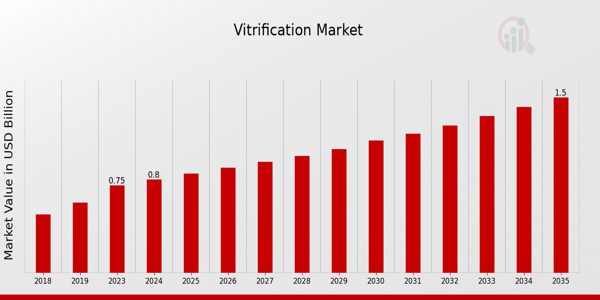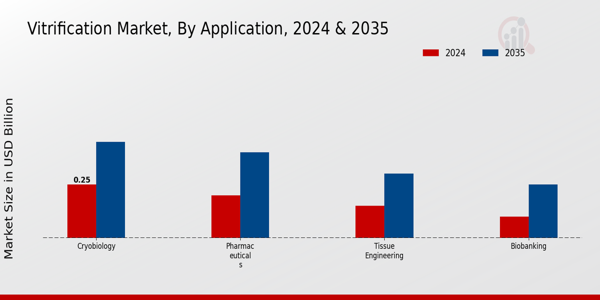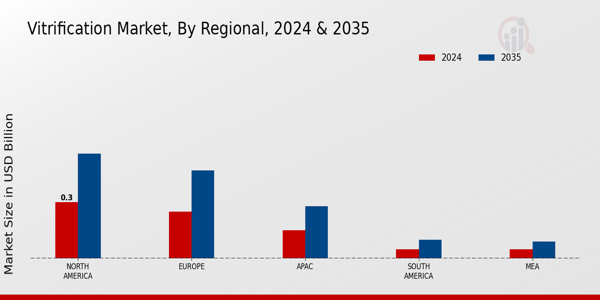Vitrification Market Overview
As per MRFR analysis, the Vitrification Market Size was estimated at 0.75 (USD Billion) in 2023. The Vitrification Market Industry is expected to grow from 0.8(USD Billion) in 2024 to 1.5 (USD Billion) by 2035. The Vitrification Market CAGR (growth rate) is expected to be around 5.89% during the forecast period (2025 - 2035).
Key Vitrification Market Trends Highlighted
The Global Vitrification Market is experiencing significant growth driven by the increasing demand for assisted reproductive technology and the rising awareness regarding the benefits of vitrification over traditional cryopreservation methods. As more clinics adopt advanced vitrification techniques, there is a push for better success rates in embryo preservation, leading to a higher success rate in in vitro fertilization (IVF) treatments. Enhanced product offerings and technological innovations by key players in this field are further fueling market growth. There are ample opportunities for businesses in the vitrification market to expand their offerings and tap into emerging markets.
The rise in infertility rates and the growing preference for delayed pregnancies among couples are creating a need for effective reproductive solutions. Additionally, the development of innovative vitrification solutions could lead to improved outcomes for patients, making it a critical area for investment. Companies can explore partnerships with fertility clinics and research institutions to advance their technologies and gain a competitive edge in the industry. Recent trends highlight a growing focus on personalized treatments in reproductive health, with vitrification becoming integral to tailored IVF protocols. The increased collaboration between research institutes and reproductive health organizations has led to advancements in vitrification techniques, ensuring better embryo survival rates.Moreover, the development of user-friendly laboratory equipment and the integration of digital technologies in monitoring and preserving embryos are shaping the future of the vitrification market. As more researchers and practitioners recognize the benefits of these advancements, the market is poised for a notable transformation in the near future.

Source: Primary Research, Secondary Research, MRFR Database and Analyst Review
Vitrification Market Drivers
Increasing Adoption of Assisted Reproductive Technologies (ART)
The Global Vitrification Market Industry is experiencing significant growth due to the increasing adoption of assisted reproductive technologies (ART) worldwide. The incorporation of vitrification techniques in ART has revolutionized the way embryos and oocytes are cryopreserved, leading to improved success rates in IVF procedures. As more couples and individuals seek fertility treatment due to factors such as delayed marriages, lifestyle changes, and rising infertility rates, the demand for effective cryopreservation methods is on the rise.Vitrification offers numerous advantages over traditional freezing techniques, including reduced ice crystal formation, enhanced cell viability, and superior embryo quality upon thawing. These benefits make vitrification the preferred method among fertility clinics globally, thereby boosting the growth of the Global Vitrification Market Industry. Furthermore, advancements in technology and methodologies related to vitrification are continually improving its safety and efficiency, encouraging more clinics to adopt these techniques and thereby driving market expansion.With the increasing investment in fertility clinics and ART procedures, the Global Vitrification Market is well-positioned for sustained growth in the coming years.
Technological Advancements in Cryopreservation Techniques
Technological advancements in cryopreservation techniques are one of the key drivers propelling the growth of the Global Vitrification Market Industry. Innovations such as improved vitrification devices, enhanced protocols, and better cryoprotectants are making it easier and more effective to freeze and thaw reproductive cells. These developments have not only increased the efficiency of the vitrification process but have also enhanced the success rates of subsequent fertilization.
Rising Awareness About Fertility Preservation
Rising awareness about fertility preservation among the general population is significantly contributing to the growth of the Global Vitrification Market Industry. As individuals become more educated about their reproductive health, they are increasingly considering options to preserve their fertility for personal or medical reasons. Factors such as late marriages, career-oriented lifestyles, and medical conditions that affect fertility have led to a growing interest in vitrification as a method for preserving embryos and oocytes.This heightened awareness is particularly evident among young professionals who may wish to delay starting a family while pursuing their careers. Additionally, awareness campaigns conducted by healthcare providers and organizations are further amplifying interest in fertility preservation techniques. As consumers demand safer, more effective methods for preserving reproductive cells, the Global Vitrification Market is expected to expand, driven by this growing consumer interest.
Vitrification Market Segment Insights
Vitrification Market Application Insights
The Global Vitrification Market is poised for substantial growth in the coming years, with a total market valuation expected to reach 0.8 USD Billion in 2024 and expand to 1.5 USD Billion by 2035. This growth trajectory is supported by key applications across various sectors, particularly Cryobiology, Pharmaceuticals, Tissue Engineering and Biobanking. In 2024, Cryobiology holds a significant market share valued at 0.25 USD Billion, reflecting its importance in the preservation of biological samples and its growing application in regenerative medicine and assisted reproductive technology. This segment is anticipated to see its value rise to 0.45 USD Billion by 2035, emphasizing the increasing reliance on vitrification techniques for effective long-term specimen storage. Pharmaceuticals also play a pivotal role within the Global Vitrification Market, with a valuation of 0.20 USD Billion in 2024, expected to double to 0.40 USD Billion by 2035. The use of vitrification in drug formulation and the stabilization of biological compounds has gained traction, driven by the pharmaceutical industry's continuous innovation and demands for more efficient preservation methods.
Furthermore, the Tissue Engineering application segment, valued at 0.15 USD Billion in 2024, is projected to reach 0.30 USD Billion by 2035. This demonstrates the essential role of vitrification in the development of viable tissue grafts and cellular therapies. The ability to preserve cells and tissues without ice crystal formation is a game-changer in regenerative medicine, influencing research and clinical applications alike. Biobanking, although the smallest in scale with a value of 0.10 USD Billion in 2024, illustrates a growing awareness and need for maintaining vast repositories of biological materials, aiming to reach 0.25 USD Billion by 2035.
The importance of biobanking hotspots for research and clinical applications is increasingly recognized, enabling breakthroughs in personalized medicine and genetic studies. Overall, the Global Vitrification Market segmentation highlights distinct areas of growth, driven by each application's unique contributions to medical science and research while also reflecting the ongoing trends shaping the biotechnology and healthcare sectors.
Factors such as advancements in freezing techniques, the rising adoption of regenerative medicine, and the focus on long-term sustainability in sample preservation are key drivers bolstering market growth. However, challenges such as high costs and the need for specialized equipment may pose hurdles. Despite this, the ongoing interest in biopharmaceuticals and advancements in cellular therapy present significant opportunities, suggesting a vibrant future for the Global Vitrification Market.

Source: Primary Research, Secondary Research, MRFR Database and Analyst Review
Vitrification Market Product Type Insights
The Global Vitrification Market, with a projected valuation of. Each of these product types plays a critical role in the overall market growth, reflecting significant shifts in technology and demand. Vitrification Media is utilized extensively in cryopreservation processes, which has propelled its importance in various clinical and research applications. Meanwhile, Vitrification Equipment contributes to enhancing efficiency and precision in procedures, further solidifying its market position.Vitrification Kits, combining essential components for vitrification processes, have seen increased adoption due to their convenience and effectiveness. Together, these components comprise a significant influencer within the Global Vitrification Market statistics, indicating a trend towards advanced solutions in assisted reproductive technology and biobanking. The overall market dynamics suggest that the expansion of healthcare facilities and rising awareness regarding fertility treatments and preservation methods will boost the segment's growth, presenting various growth opportunities amidst challenges such as regulatory compliance and high initial costs.
Vitrification Market End Use Insights
The Global Vitrification Market is witnessing significant growth, particularly in its End Use segment, which plays an integral role in advancing various biomedical applications. As pivotal players, Research Institutions leverage vitrification for critical studies related to cellular and genetic research, thus driving market growth. Biotechnology Companies actively utilize these technologies to enhance product development, positioning themselves as major contributors to the market.Pharmaceutical Companies benefit from vitrification in drug formulation and preservation, emphasizing its importance in the pharmaceutical industry. Hospitals and Clinics also represent a significant portion of the market, adopting vitrification methods to improve patient outcomes and treatment efficacy. The increasing emphasis on regenerative medicine and advanced therapeutic procedures has enabled these sectors to dominate the Global Vitrification Market, showcasing their vital role within the industry and contributing to robust growth opportunities.Market growth in these areas is further supported by continual advancements in technology and increasing collaborations among industry stakeholders.
Vitrification Market Methodology Insights
The market is characterized by its division into methodologies such as Open Vitrification and Closed Vitrification. Open Vitrification holds a significant share, as it allows greater ease of handling samples, making it an attractive option for laboratories. Conversely, Closed Vitrification is gaining traction due to its ability to prevent contamination and ensure higher safety standards, which is crucial in sensitive environments like stem cell storage and IVF.As the Global Vitrification Market continues to evolve, innovations in both methodologies are anticipated to drive efficiency and effectiveness in sample preservation. However, challenges such as technological limitations and high costs may affect market growth. Overall, the Global Vitrification Market revenue is poised for continuous expansion, with the need for reliable and effective vitrification techniques fueling ongoing research and development efforts. The underlying trends in the market reflect a focus on enhancing safety while improving the capabilities of existing methodologies.
Vitrification Market Regional Insights
The Global Vitrification Market is poised for growth across various regional segments, demonstrating distinct market valuations and trends. In 2024, North America leads with a valuation of 0.3 USD Billion, expected to grow to 0.56 USD Billion by 2035, indicating its dominant role in the market. Europe follows closely with a valuation of 0.25 USD Billion in 2024 and projected to reach 0.47 USD Billion in 2035, highlighting its significant market presence. The Asia-Pacific region, valued at 0.15 USD Billion in 2024 and anticipated to grow to 0.28 USD Billion by 2035, shows promise due to increasing technological adoption and rising healthcare expenditures.Meanwhile, South America and the Middle East Africa regions, with valuations of 0.05 USD Billion and 0.05 USD Billion respectively in 2024, are expected to grow steadily, reaching 0.1 USD Billion and 0.09 USD Billion by 2035. The North American segment dominates due to advanced healthcare infrastructure and robust research initiatives, while the emerging markets in APAC are witnessing rapid innovation, presenting ample opportunities for growth. These dynamics shape the Global Vitrification Market statistics, indicating ongoing growth drivers, challenges, and competitive landscape across these regions.

Source: Primary Research, Secondary Research, MRFR Database and Analyst Review
Vitrification Market Key Players and Competitive Insights
The Global Vitrification Market is characterized by a dynamic competitive landscape where various players strive to consolidate their positions through innovation, quality enhancement and strategic collaborations. This market chiefly serves the fields of reproductive medicine, stem cell therapy, and preservation of biological samples, where the quality of vitrification solutions plays a crucial role in achieving successful outcomes. As the demand for advanced and efficient cryopreservation techniques escalates due to the growing awareness regarding infertility treatments and the need for quality biological samples in research, companies within this market are continuously evolving and adapting to the latest technological advancements. Key players focus on expanding their product portfolios, enhancing their distribution channels, and optimizing their operational efficiencies to cater to the increasing needs of healthcare providers and researchers worldwide.
CryoLife stands out in the Global Vitrification Market with its solid reputation for quality and reliability in cryopreservation solutions. The company emphasizes innovative products that ensure the integrity of biological materials during the freezing and thawing processes, which is vital for successful applications in reproductive health. CryoLife leverages its extensive experience in the field to develop and provide advanced vitrification techniques that enhance clinical outcomes. Its strong market presence is reinforced by a commitment to research and development, enabling the company to offer cutting-edge solutions that meet the evolving needs of clinicians and laboratories.
The focus on customer support and education in the effective use of its products further cements CryoLife's reputation as a trusted partner in the field of vitrification, allowing it to maintain a competitive edge.Merck KGaA is another prominent player in the Global Vitrification Market, renowned for its strong position and broad portfolio of high-quality vitrification products. The company invests significantly in research and development, ensuring that its offerings are at the forefront of technological advances in cryopreservation. Merck KGaA emphasizes sustainability and efficiency in its production processes, which not only enhances product performance but also resonates with the industry’s growing demand for eco-friendly solutions. The company’s global reach is supported by robust distribution networks that facilitate access to its innovative vitrification technologies across various geographical regions. Moreover, Merck KGaA continuously engages with the scientific community to foster developments in vitrification techniques, showcasing its commitment to advancing the overall field and supporting healthcare professionals in achieving optimal outcomes.
Key Companies in the Vitrification Market Include
- CryoLife
- Merck KGaA
- Irvine Scientific
- BristolMyers Squibb
- Thermo Fisher Scientific
- Hamilton Thorne
- Embryo Technologies
- Cook Medical
- Vitrolife
- EUSA Pharma
- INVO Bioscience
- Revive Adherence Sciences
- Fertility Preservation
- Genea Limited
Vitrification Market Industry Developments
Recent developments in the Global Vitrification Market have highlighted increased investments and advancements in cryopreservation technologies. Companies like CryoLife and Merck KGaA are expanding their product offerings, focusing on innovative solutions for fertility preservation. Irvine Scientific has recently enhanced its portfolio with new vitrification media, reflecting a strong demand for quality in reproductive health. Bristol-Myers Squibb and Thermo Fisher Scientific are also making significant strides in research collaborations aimed at improving embryo viability rates through better vitrification practices.Mergers and acquisitions have shaped the competitive landscape, with several companies exploring strategic partnerships to consolidate their market positions. Notable transactions involving Hamilton Thorne and Cook Medical are anticipated to augment their technological capabilities and distribution networks. The robust growth of the Global Vitrification Market is further influenced by the increasing number of fertility treatments, prompting a surge in the need for efficient cryopreservation techniques. Market valuation is experiencing upward momentum, creating opportunities for companies like Vitrolife and EUSA Pharma, which are expanding their global reach and driving innovation in the field.
Vitrification Market Segmentation Insights
Vitrification Market Application Outlook
Vitrification Market Product Type Outlook
- Vitrification Media
- Vitrification Equipment
- Vitrification Kits
Vitrification Market End Use Outlook
- Research Institutions
- Biotechnology Companies
- Pharmaceutical Companies
- Hospitals and Clinics
Vitrification Market Methodology Outlook
- Open Vitrification
- Closed Vitrification
Vitrification Market Regional Outlook
- North America
- Europe
- South America
- Asia Pacific
- Middle East and Africa
|
Report Attribute/Metric
|
Details
|
|
Market Size 2023
|
0.75 (USD Billion)
|
|
Market Size 2024
|
0.8 (USD Billion)
|
|
Market Size 2035
|
1.5 (USD Billion)
|
|
Compound Annual Growth Rate (CAGR)
|
5.89% (2025 - 2035)
|
|
Report Coverage
|
Revenue Forecast, Competitive Landscape, Growth Factors, and Trends
|
|
Base Year
|
2024
|
|
Market Forecast Period
|
2025 - 2035
|
|
Historical Data
|
2019 - 2024
|
|
Market Forecast Units
|
USD Billion
|
|
Key Companies Profiled
|
CryoLife, Merck KGaA, Irvine Scientific, Bristol-Myers Squibb, Thermo Fisher Scientific, Hamilton Thorne, Embryo Technologies, Cook Medical, Vitrolife, EUSA Pharma, INVO Bioscience, Revive Adherence Sciences, Fertility Preservation, Genea Limited
|
|
Segments Covered
|
Application, Product Type, End Use, Methodology, Regional
|
|
Key Market Opportunities
|
1. Increasing demand for IVF techniques,
2. Advancements in cryopreservation technologies,
3. Rising awareness of fertility preservation,
4. Growth in regenerative medicine applications,
5. Expanding applications in biobanking solutions
|
|
Key Market Dynamics
|
1. Increasing demand for cell preservation,
2. Advancements in cryopreservation technology,
3. Rising applications in biotechnology,
4. Growing fertility tourism,
5. Stringent regulatory compliance requirements
|
|
Countries Covered
|
North America, Europe, APAC, South America, MEA
|
Frequently Asked Questions (FAQ) :
The Vitrification Market is expected to be valued at 0.8 USD Billion in 2024.
The Vitrification Market is projected to have a CAGR of 5.89% from 2025 to 2035.
North America is expected to dominate the Global Vitrification Market with a value of 0.3 USD Billion in 2024.
The Cryobiology application of the Global Vitrification Market is expected to be valued at 0.45 USD Billion in 2035.
The Pharmaceuticals application is expected to reach a market value of 0.4 USD Billion by 2035.
The projected market size for Europe in 2035 is expected to be 0.47 USD Billion.
Key players in the Global Vitrification Market include CryoLife, Merck KGaA, and Vitrolife among others.
The Biobanking application is expected to be valued at 0.25 USD Billion in 2035.
The expected market size for the APAC region in 2024 is 0.15 USD Billion.
The Tissue Engineering application is expected to grow to a value of 0.3 USD Billion by 2035.

















